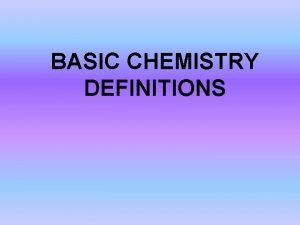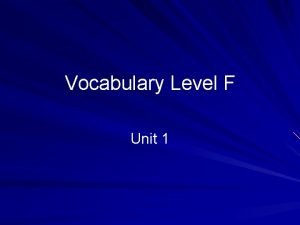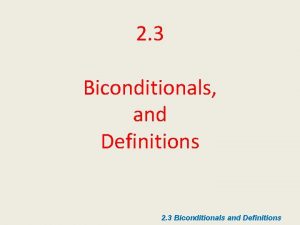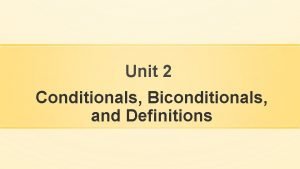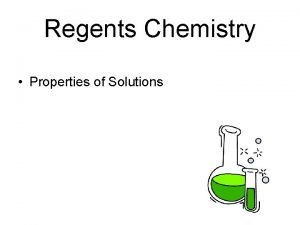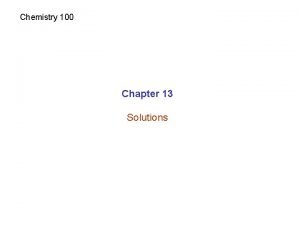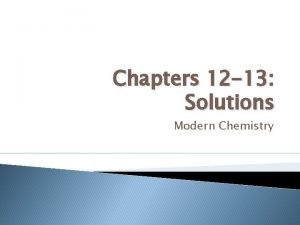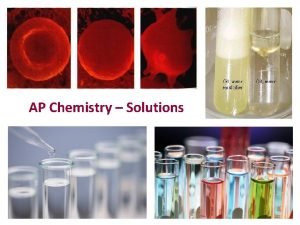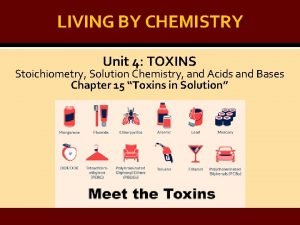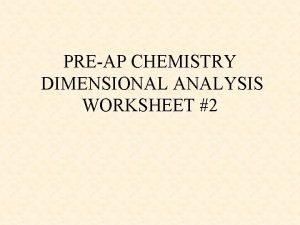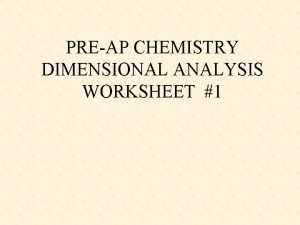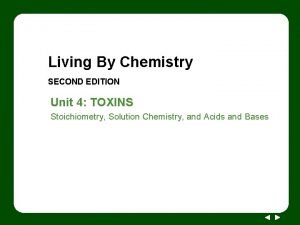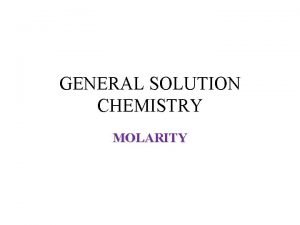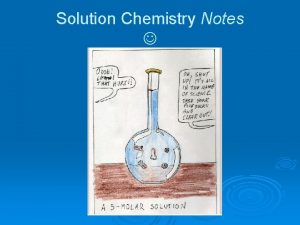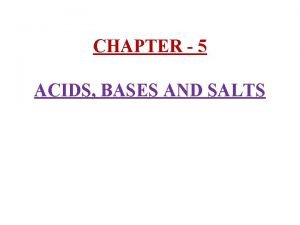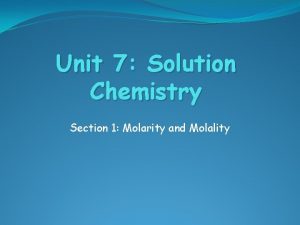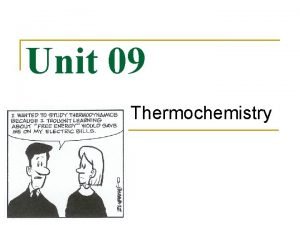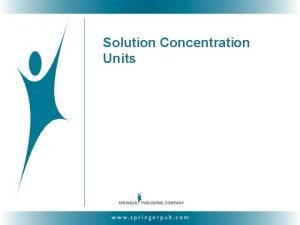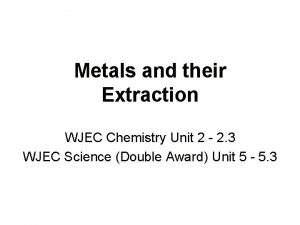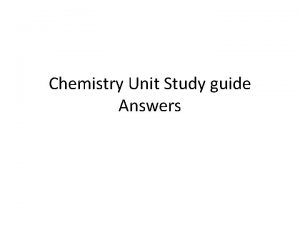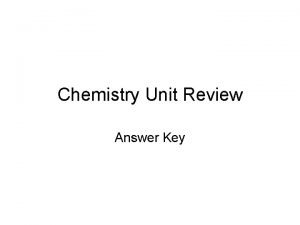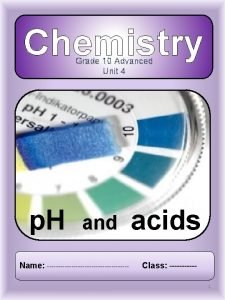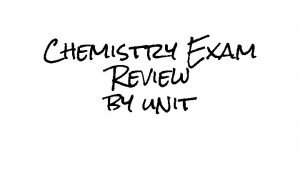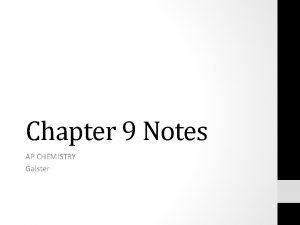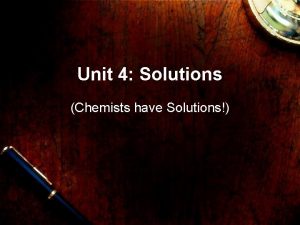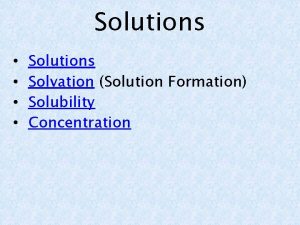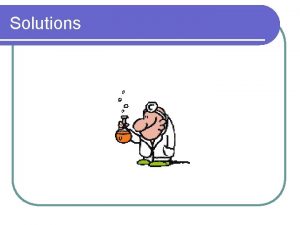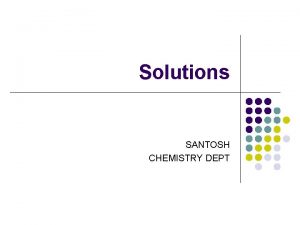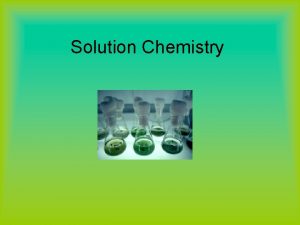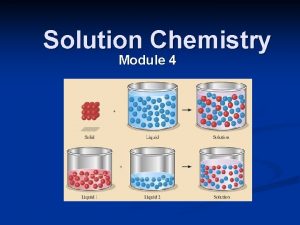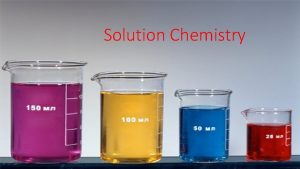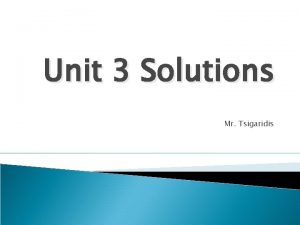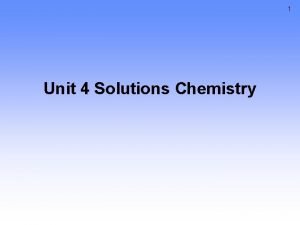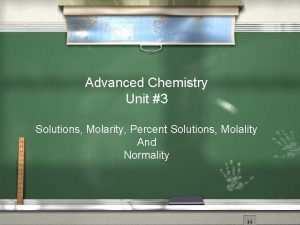Chemistry Unit 10 Solutions Solution Definitions solution a












![Solids dissolved in liquids Gases dissolved in liquids [O Sol. 2] Sol. To As Solids dissolved in liquids Gases dissolved in liquids [O Sol. 2] Sol. To As](https://slidetodoc.com/presentation_image_h/0c6b3a2684d9bf2f3b71ab0e738dc280/image-13.jpg)

























- Slides: 38

Chemistry Unit 10: Solutions

Solution Definitions solution: a homogeneous mixture -- evenly mixed at the particle level -- e. g. , salt water alloy: a solid solution of metals -- e. g. , bronze = Cu + Sn; brass = Cu + Zn solvent: the substance that dissolves the solute e. g. , water e. g. , salt

soluble: “will dissolve in” miscible: refers to two liquids that mix evenly in all proportions -- e. g. , food coloring and water

Factors Affecting the Rate of Dissolution 1. temperature 2. particle size 3. mixing 4. nature of solvent or solute As temp. , rate As size rate , With more mixing, rate We can’t control this factor.

Classes of Solutions aqueous solution: solvent = water = “the universal solvent” amalgam: solvent = mercury e. g. , dental amalgam tincture: solvent = alcohol e. g. , tincture of iodine (for cuts) organic solution: solvent carbon contains ____ Organic solvents include benzene, toluene, hexane, etc.

Non-Solution Definitions insoluble: “will NOT dissolve in” e. g. , sand water immiscible: refers to two liquids that will NOT form a solution e. g. , water and oil suspension: appears uniform while being stirred, but settles over time e. g. , liquid medications

H H–C–H H Molecular Polarity nonpolar molecules: -- e– are shared equally -- tend to be symmetric e. g. , fats and oils polar molecules: -- e– NOT shared equally e. g. , water H H O “Like dissolves like. ” polar + polar = solution nonpolar + nonpolar = solution polar + nonpolar = suspension (won’t mix evenly)

Using Solubility Principles Chemicals used by body obey solubility principles. -- water-soluble vitamins: e. g. , vitamin C -- fat-soluble vitamins: e. g. , vitamins A & D Anabolic steroids and HGH are fat-soluble, synthetic hormones.

Using Solubility Principles (cont. ) Dry cleaning employs nonpolar liquids. -- polar liquids damage wool, silk -- also, dry clean for stubborn stains (ink, rust, grease) -- tetrachloroethylene was in longtime use Cl Cl C=C Cl Cl

emulsifying agent (emulsifier): -- molecules w/both a polar AND a nonpolar end -- allows polar and nonpolar substances to mix e. g. , soap eggs lecithin MODEL OF A SOAP MOLECULE Na 1+ POLAR HEAD NONPOLAR HYDROCARBON TAIL detergent

soap vs. -- made from animal and vegetable fats Na 1+ POLAR HEAD detergent -- made from petroleum -- works better in hard water NONPOLAR HYDROCARBON TAIL Hard water contains minerals w/ions like Ca 2+, Mg 2+, and Fe 3+ that replace Na 1+ at polar end of soap molecule. Soap is changed into an insoluble H 2 O precipitate (i. e. , soap scum). HO 2 micelle: a liquid droplet covered w/soap or detergent molecules oil H 2 O

Solubility sudden stress causes this much ppt how much solute dissolves in a given amt. of solvent at a given temp. SOLUBILITY CURVE KNO 3 (s) KCl (s) Solubility (g/100 g H 2 O) HCl (g) Temp. (o. C) unsaturated: sol’n could hold more solute; below the line saturated: sol’n has “just right” amt. of solute; on the line supersaturated: sol’n has “too much” solute dissolved in it; above the line
![Solids dissolved in liquids Gases dissolved in liquids O Sol 2 Sol To As Solids dissolved in liquids Gases dissolved in liquids [O Sol. 2] Sol. To As](https://slidetodoc.com/presentation_image_h/0c6b3a2684d9bf2f3b71ab0e738dc280/image-13.jpg)
Solids dissolved in liquids Gases dissolved in liquids [O Sol. 2] Sol. To As To , solubility ___

per 100 g H 2 O Using an available solubility curve, classify as unsaturated, or supersaturated. 80 g Na. NO 3 @ 30 o. C unsaturated 45 g KCl @ 60 o. C saturated 30 g KCl. O 3 @ 30 o. C supersaturated 70 g Pb(NO 3)2 @ 60 o. C unsaturated

(Unsaturated, or supersaturated? ) Per 500 g H 2 O, 100 g KNO 3 @ 40 o. C saturation point @ 40 o. C for 100 g H 2 O = 63 g KNO 3 So saturation pt. @ 40 o. C for 500 g H 2 O = 5 x 63 g = 315 g 100 g < 315 g unsaturated

Describe each situation below. (A) Per 100 g H 2 O, 100 g Na. NO 3 @ 50 o. C. unsaturated; all solute dissolves; clear sol’n. (B) Cool sol’n (A) very slowly to 10 o. C. supersaturated; extra solute remains in sol’n; still clear (C) Quench sol’n (A) in an ice bath to 10 o. C. saturated; extra solute (20 g) can’t remain in sol’n and becomes visible

Glassware – Precision and Cost beaker vs. 1000 m. L + 5% volumetric flask 1000 m. L + 0. 30 m. L When filled to 1000 m. L line, how much liquid is present? WE DON’T KNOW. min: 950 m. L max: 1050 m. L imprecise; cheap Range: 5% of 1000 m. L = 50 m. L min: 999. 70 m. L max: 1000. 30 m. L precise; expensive

water in grad. cyl. mercury in grad. cyl. measure to bottom measure to top ** Measure to part of meniscus w/zero slope.

Concentration…a measure of solute-to-solvent ratio concentrated dilute “lots of solute” “not much solvent” “watery” Add water to dilute a sol’n; boil water off to concentrate it.

Selected units of concentration A. mass % = mass of solute x 100 mass of sol’n B. parts per million (ppm) = mass of solute x 106 mass of sol’n also, ppb and ppt (Use 109 or 1012 here) mol -- commonly used for minerals or contaminants in water supplies M L C. molarity (M) = moles of solute L of sol’n -- used most often in this class

How many mol solute are req’d to make 1. 35 L of 2. 50 M sol’n? mol = M L = 2. 50 M (1. 35 L ) = 3. 38 mol M L A. What mass sodium hydroxide is this? Na 1+ OH 1– Na. OH 3. 38 mol = 135 g Na. OH B. What mass magnesium phosphate is this? Mg 2+ PO 43– Mg 3(PO 4)2 3. 38 mol = 889 g Mg 3(PO 4)2

Find molarity if 58. 6 g barium hydroxide are Ba 2+ OH 1– in 5. 65 L sol’n. mol Ba(OH)2 M L 58. 6 g = 0. 342 mol = 0. 061 M Ba(OH)2 You have 10. 8 g potassium nitrate. How many m. L of sol’n will make this a 0. 14 M sol’n? K 1+ NO 31– KNO 3 10. 8 g = 0. 1068 mol (convert to m. L) = 0. 763 L = 763 m. L

Molarity and Stoichiometry m V mol P mol ML Pb. I 2 m V ML V of sol’ns P V of gases at STP KI 1 2 __Pb(NO 3)2(aq) + __KI (aq) __Pb. I 2(s) + __KNO 3(aq) What volume of 4. 0 M KI sol’n is req’d to yield 89 g Pb. I 2? Strategy: (1) Find mol KI needed to yield 89 g Pb. I 2. (2) Based on (1), find volume of 4. 0 M KI sol’n.

1 2 __Pb(NO 3)2(aq) + __KI (aq) __Pb. I 2(s) + __KNO 3(aq) What volume of 4. 0 M KI sol’n is req’d to yield 89 g Pb. I 2? Strategy: (1) Find mol KI needed to yield 89 g Pb. I 2. (2) Based on (1), find volume of 4. 0 M KI sol’n. 89 g Pb. I 2 KI ML ML = 0. 39 mol KI mol = 0. 098 L of 4. 0 M KI M L

Cu How many m. L of a 0. 500 M Cu. SO 4 sol’n will react w/excess Al to produce 11. 0 g Cu? Cu. SO 4 Al 3+ SO 42– ML ML 3 2 3 1 __Cu. SO 4(aq) + __Al(s) __Cu(s) + __Al 2(SO 4)3(aq) 11. 0 g Cu = 0. 173 mol Cu. SO 4 = 0. 346 L = 346 m. L of 0. 500 M Cu. SO 4 mol M L

Dilutions of Solutions Acids (and sometimes bases) are purchased in concentrated form (“concentrate”) and are easily diluted to any desired concentration. **Safety Tip: When diluting, add acid (or base) to water. Dilution Equation: MC VC = MD VD C = conc. D = dilute

Conc. H 3 PO 4 is 14. 8 M. What volume of concentrate is req’d to make 25. 00 L of 0. 500 M H 3 PO 4? MC V C = M D V D 14. 8 (VC) = 0. 500 (25) 14. 8 VC = 0. 845 L How would you mix the above sol’n? 0. 845 L of conc. H 3 PO 4. 1. Measure out _____ ~20 L of cold H 2 O. 2. In separate container, obtain ____ 3. In fume hood, slowly pour H 3 PO 4 into cold H 2 O. 4. Add enough H 2 O until 25. 00 L of sol’n is obtained.

Cost Analysis with Dilutions 2. 5 L of 12 M HCl (i. e. , “concentrate”) 0. 500 L of 0. 15 M HCl Cost: $25. 71 Cost: $6. 35 How many 0. 500 L-samples of 0. 15 m HCl can be made from the bottle of concentrate? MC V C = M D V D (Expensive water!) 12 M (2. 5 L) = 0. 500 M (VD) VD = 200 L Moral: Buy the concentrate and mix it yourself to any desired concentration. 400 samples @ $6. 35 ea. = $2, 540

You have 75 m. L of conc. HF (28. 9 M); you need 15. 0 L of 0. 100 M HF. Do you have enough to do the experiment? MC V C = M D V D 28. 9 M (0. 075 L) = 0. 100 M (15 L) Calc. how much conc. you need… 28. 9 M (VC) = 0. 100 M (15 L) VC = 0. 052 L = 52 m. L needed Yes; we’re OK.

Dissociation occurs when neutral combinations of particles separate into ions while in aqueous solution. sodium chloride Na. Cl Na 1+ + Cl 1– sodium hydroxide Na. OH Na 1+ + OH 1– hydrochloric acid HCl H 1+ + Cl 1– sulfuric acid H 2 SO 4 2 H 1+ + SO 42– acetic acid CH 3 COOH CH 3 COO 1– + H 1+ acids yield hydrogen (H 1+) ions in aque. In general, _____ ous solution; bases _____ yield hydroxide (OH 1–) ions.

Strong electrolytes exhibit nearly 100% dissociation. NOT in water: in aq. sol’n: Na. Cl Na 1+ + Cl 1– 1000 0 0 1 999 Weak electrolytes exhibit little dissociation. CH 3 COOH CH 3 COO 1– + H 1+ NOT in water: 1000 0 0 in aq. sol’n: 980 20 20 “Strong” or “weak” is a property of the substance. We can’t change one into the other.

electrolytes: solutes that dissociate in sol’n -- conduct elec. current because of free-moving ions -- e. g. , acids, bases, most ionic compounds -- are crucial for many cellular processes -- obtained in a healthy diet -- For sustained exercise or a bout of the flu, sports drinks ensure adequate electrolytes.

nonelectrolytes: solutes that DO NOT dissociate -- DO NOT conduct elec. current (not enough ions) -- e. g. , any type of sugar

Colligative Properties properties that depend on the conc. of a sol’n Compared to solvent’s… a sol’n w/that solvent has a… …normal freezing …lower FP point (NFP) (freezing point depression) …normal boiling point (NBP) …higher BP (boiling point elevation)

Applications of Colligative Properties (NOTE: Data are fictitious. ) 1. salting roads in winter FP BP water 0 o. C (NFP) 100 o. C (NBP) water + a little salt – 11 o. C 103 o. C water + more salt – 18 o. C 105 o. C

Applications of Colligative Properties (cont. ) 2. Antifreeze (AF) (a. k. a. , “coolant”) FP BP water 0 o. C (NFP) 100 o. C (NBP) water + a little AF – 10 o. C 110 o. C 50% water + 50% AF – 35 o. C 130 o. C

Applications of Colligative Properties (cont. ) 3. law enforcement white powder starts melting at… finishes melting at… A 120 o. C 150 o. C comm. service B 130 o. C 140 o. C 2 yrs. C 134 o. C 136 o. C 20 yrs. penalty, if convicted

h h
 Basic chemistry definitions
Basic chemistry definitions Definitions of solution
Definitions of solution Vocabulary workshop level f unit 10 synonyms
Vocabulary workshop level f unit 10 synonyms Vocabulary workshop level f unit 1 test
Vocabulary workshop level f unit 1 test Unit 3 lesson 2 biconditionals and definitions
Unit 3 lesson 2 biconditionals and definitions Conditionals and biconditionals
Conditionals and biconditionals Ib organic chemistry functional groups
Ib organic chemistry functional groups Inorganic vs organic chemistry
Inorganic vs organic chemistry Unit 10, unit 10 review tests, unit 10 general test
Unit 10, unit 10 review tests, unit 10 general test Colligative properties regents questions
Colligative properties regents questions Chapter 12 review solutions section 3
Chapter 12 review solutions section 3 Chapter 13 mixtures and solutions answers
Chapter 13 mixtures and solutions answers Modern chemistry solutions
Modern chemistry solutions Gas liquid solid
Gas liquid solid Living by chemistry solutions
Living by chemistry solutions Dimensional analysis worksheet 2
Dimensional analysis worksheet 2 Chemistry dimensional analysis practice
Chemistry dimensional analysis practice Living by chemistry solutions
Living by chemistry solutions Chemistry in biology chapter 6
Chemistry in biology chapter 6 What is the molarity of a solution
What is the molarity of a solution Difference between mixture and solution
Difference between mixture and solution Definition of solution in chemistry
Definition of solution in chemistry Natural indicators
Natural indicators Immiscible
Immiscible Chemistry unit 9 lesson 4
Chemistry unit 9 lesson 4 Unit 7 ap chemistry
Unit 7 ap chemistry Chemistry unit 7 molarity
Chemistry unit 7 molarity Unit 9 thermochemistry
Unit 9 thermochemistry Chemistry semester 2 review unit 12 thermochemistry
Chemistry semester 2 review unit 12 thermochemistry Units for molarity
Units for molarity Wjec chemistry unit 2
Wjec chemistry unit 2 Unit 8 ap chemistry
Unit 8 ap chemistry Grade 11 chemistry unit 4
Grade 11 chemistry unit 4 Chemistry unit 1 study guide
Chemistry unit 1 study guide Chemistry unit review answer key
Chemistry unit review answer key Chemistry grade 10 unit 4
Chemistry grade 10 unit 4 Unit 6 chemistry review
Unit 6 chemistry review Ap chemistry unit 9 notes
Ap chemistry unit 9 notes Higher chemistry unit 3
Higher chemistry unit 3
